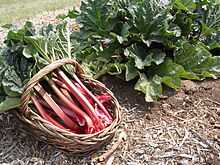Petiole (botany)

In botany, the petiole /ˈpiːtɨoʊl/ is the stalk attaching the leaf blade to the stem.[1] The petiole is the transition between the stem and the leaf blade,[2]:171 and usually has the same internal structure as the stem. Outgrowths appearing on each side of the petiole are called stipules. Leaves lacking a petiole are called sessile or epetiolate, in which case the blade attaches directly to the stem, or clasping when they partly surround the stem. Subpetiolate leaves are nearly petiolate, or have an extremely short petiole, and appear sessile. [2]:157 Clasping leaves of the Poaceae have an extra structure called the ligule. Petiolate leaves are ones where the petiole connects to the leaf before its apex.
Description

In some plants, the petioles become flattened and widened, and the true leaves may become reduced or vanish altogether. These are known as phyllodes or phyllodia, or cladophylls. Thus, the phyllode comes to serve the purpose of the leaf. Phyllodes are common in the genus Acacia, especially the Australian species, at one time put in Acacia subgenus Phyllodineae. Sometimes, especially on younger plants, partially formed phyllodes bearing reduced leaves can be seen.
In Acacia koa, the phyllodes are leathery and thick, allowing the tree to survive stressful environments. The petiole allows partially submerged hydrophytes to have leaves floating at different depths, the petiole being between the node and the stem.
In plants such as rhubarb (Rheum rhabarbarum) the petiole ("stalk") is harvested as a crop. The petiole grows directly from the root and produces the rhubarb leaf at its end. Botanically it is categorized as a vegetable and culinarily used as a fruit.[3][4]
Etymology
Petiole is pronounced /ˈpiːtɨoʊl/ and comes from Latin petiolus, or peciolus "little foot," "stem", an alternative diminutive of pes "foot." The regular diminutive pediculus is also used for "foot stalk".
See also
References
- ↑ Dictionary Reference. "Petiole". Dictionary.reference.com. Retrieved 25 February 2012.
- ↑ 2.0 2.1 Mauseth, James D (2003). Botany: An Introduction to Plant Biology. Jones & Bartlett Learning. ISBN 0-7637-2134-4.
- ↑ Foust, Clifford M. (1992). Rhubarb: The Wondrous Drug. Princeton: Princeton University Press. ISBN 0-691-08747-4.
- ↑ High Altitude Rhubarb
External links
 "Petiole". Collier's New Encyclopedia. 1921.
"Petiole". Collier's New Encyclopedia. 1921.